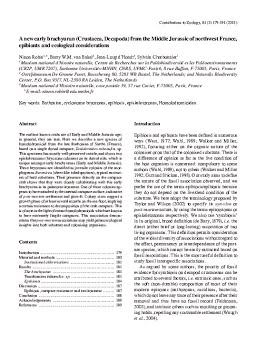2015
A new early brachyuran (Crustacea, Decapoda) from the Middle Jurassic of northwest France, epibionts and ecological considerations
Publication
Publication
Contributions to Zoology , Volume 84 - Issue 3 p. 179- 191
The earliest known crabs are of Early and Middle Jurassic age; in general, they are rare. Here we describe a new species of homolodromioid from the late Bathonian of Sarthe (France), based on a single dorsal carapace, Tanidromites raboeufi n. sp. This specimen has mostly well-preserved cuticle, and shows two episkeletozoans (bryozoan colonies) on its dorsal side, which is unique amongst early brachyurans (Early and Middle Jurassic). These bryozoans are identified as juvenile colonies of the morphogenus Berenicea (sheet-like tubuluporines), typical encrusters of hard substrates. Their presence directly on the carapace crab shows that they were closely cohabitating with this early brachyuran in its palaeoenvironment. One of these colonies appears to have attached to the internal carapace surface, indicative of post-mortem settlement and growth. Colony sizes suggest a growth phase of at least several months on the sea floor, implying a certain resistance to decomposition of the crab carapace. This is of note in the light of extant homolodromioids which are known to have extremely fragile carapaces. This association demonstrates that post-mortem associations may yield palaeoecological insights into both substrate and colonising organisms.
| Additional Metadata | |
|---|---|
| , , , , | |
| Contributions to Zoology | |
| Released under the CC-BY 4.0 ("Attribution") License | |
| Organisation | Naturalis journals & series |
|
Robin, N., van Bakel, B., d' Hondt, J.-L., & Charbonnier, S. (2015). A new early brachyuran (Crustacea, Decapoda) from the Middle Jurassic of northwest France, epibionts and ecological considerations. Contributions to Zoology, 84(3), 179–191. |
|
